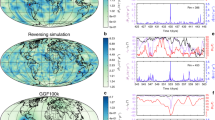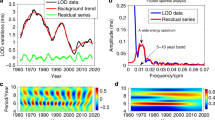Abstract
The westward movement in time of features of the pattern of the geomagnetic field on the surface of the Earth1 is termed the ‘westward drift’ and is supposed to occur because the Earth's outer, liquid core, where the main geomagnetic field originates, rotates more slowly than the mantle. The drift rate is not constant and it has been suggested2 that changes in the rotation rate of the core, as seen in the variation of westward drift, will be associated with changes in the rotation rate of the mantle, that is, in the observed length of day. Le Mouel et al.3 have recently presented evidence in support of this theory. Here I attempt to derive an estimate of westward drift from global models of the magnetic field, to determine whether a correlation can be found from the data. The conclusion reached is much less optimistic than that of Le Mouel et al.3 as the changes in length of day do not appear to follow closely the values of westward drift obtained.
This is a preview of subscription content, access via your institution
Access options
Subscribe to this journal
Receive 51 print issues and online access
$199.00 per year
only $3.90 per issue
Buy this article
- Purchase on Springer Link
- Instant access to full article PDF
Prices may be subject to local taxes which are calculated during checkout
Similar content being viewed by others
References
Halley, E. Phil. Trans. R. Soc. 17, 563–578 (1693).
Vestine, E. H. Geophys. J. R. astr. Soc. 15, 29–37 (1968).
Le Mouel, J.-L., Madden, T. R., Ducruix, J. D. & Courtillot, V. Nature 290, 763–765 (1981).
Kahle, Anne, B., Vestive, E. H. & Bail, R. H. J. geophys. Res. 72, 1095–1108 (1967).
Kahle, Anne, B., Ball, R. H. & Vestive, E. H. J. geophys. Res. 72, 4917–4936 (1967).
Bullard, E. C., Freedman, Cynthia, Gellman, H. & Nixon, Jo, Phil. Trans. R. Soc. A243, 67–92 (1960).
Yukutake, T. Bull. Earthq. Res. Inst. Tokyo Univ. 40, 1–64 (1962).
Hide, R. & Malin, S. R. C. Nature 225, 605–609 (1970).
Hodder, Barbara, M. Geophys. J. R. astr. Soc. 65, 763–776 (1981).
Morrison, L. V. Geophys. J. R. astr. Soc. 58, 349–360 (1979).
Munk, W. H. & MacDonald, G. T. F. The Rotation of the Earth (Cambridge University Press, 1960), 323pp.
Hide, R. Phil. Trans. R. Soc. A259 615–650 (1966).
Hide, R. Phil. Trans. R. Soc. A284, 547–554 (1977).
Author information
Authors and Affiliations
Rights and permissions
About this article
Cite this article
Hodder, B. Geomagnetic westward drift using the correlation coefficient. Nature 301, 136–137 (1983). https://doi.org/10.1038/301136a0
Received:
Accepted:
Issue Date:
DOI: https://doi.org/10.1038/301136a0
This article is cited by
Comments
By submitting a comment you agree to abide by our Terms and Community Guidelines. If you find something abusive or that does not comply with our terms or guidelines please flag it as inappropriate.



